| Pages:
1
..
11
12
13
14
15
..
27 |
Formatik
National Hazard
   
Posts: 927
Registered: 25-3-2008
Member Is Offline
Mood: equilibrium
|
|
Quote: Originally posted by AndersHoveland  | Is the cobalt in cobalt diazoaminotetrazole in the +2 or +3 oxidation state? formula?
Also that just plain cobalt azotetrazole, or the tetramine complex with cobalt? |
Co(II), precipitated by reaction of sodium diazoaminotetrazole and an aqueous Co(II) salt. The cobalt azotetrazolate made in the same way except using
sodium azotetrazole instead, both under regular conditions and no added base or acid present. Formula of the diazoaminotetrazolate ought to be a
hydrate of Co3(C2N11)2. Diazoaminotetrazolates have some water solubility and tend to form hydrates.
Cobalt azotetrazolate is a beige orange solid which showed no reaction to moderate hammer blows on an iron plate. Grinding on an iron plate by
dragging across with a pestle caused little to no reaction (lead azide shows some reaction there). It indents aluminium sheets. I would think it could
form ammonia complexates with very low sensitivity, but likely less brisant. Maybe worthwhile could be a hydrazine complex (trishydrazine cobalt
azotetrazolate). Combining some ideas here: maybe azotetrazolato-trishydrazinecobalt perchlorate or nitroformate.
| Quote: |
That is a complex answer. My opinion is that it is best to combine both. |
A combination of the best of both worlds.
|
|
|
NatashaJurievna
Harmless

Posts: 9
Registered: 5-2-2012
Location: Carpathians
Member Is Offline
Mood: Too warlike, not friendly
|
|
Is there any data on long term stability of hexahydroxylamine Co(ll) and Ni(ll) nitrate complexes at mild conditions (e.g. at room temperature)? Seems
not.
|
|
|
NatashaJurievna
Harmless

Posts: 9
Registered: 5-2-2012
Location: Carpathians
Member Is Offline
Mood: Too warlike, not friendly
|
|
Bis and tris(biuret) energetic complexes are also stable and not too sensitive (and cheap). For example, bis(biuret)cupric chlorate, a pale
bluish/green powder, is a fairly stable compound and a cool and flashless explosive. A perchlorate is much more energetic (deflagrates with a flame)
but too soluble in water and hygroscopic.
|
|
|
AndersHoveland
Hazard to Other Members, due to repeated speculation and posting of untested highly dangerous procedures!
    
Posts: 1986
Registered: 2-3-2011
Member Is Offline
Mood: No Mood
|
|
Better to use perchlorate. Chlorates are more chemically reactive, and their salts are much more sensitive (just compare the difference between
NH4ClO4 and NH4ClO3 !).
|
|
|
woelen
|
Thread Pruned
2-3-2012 at 03:02 |
Formatik
National Hazard
   
Posts: 927
Registered: 25-3-2008
Member Is Offline
Mood: equilibrium
|
|
Quote: Originally posted by Formatik  | | Another example of large sensitivity reduction is the complex of tetraamminecopper(II) nitrotetrazolate ... with impact sensitivity of manyfold less
than copper (II) nitrotetrazolate ... |
Correction on the compound which I think I meant here was the salt triaminocopper(II) 5-nitrotetrazolate, described in the paper: Less Sensitive Transition Metal Salts of the 5-Nitrotetrazolate Anion by Sabate and Klapoetke. This copper
complex has around the mechanical insensitivity of RDX and does not appear to be that static sensitive either.
|
|
|
RadioTrefoil
Harmless

Posts: 16
Registered: 11-7-2012
Location: New Zealand
Member Is Offline
Mood: Inert
|
|
If anybody's still interested in tetraamminecoppper(II) persulfate complex, I did some deflagration and detonation tests to accompany Axt's. The
TeACPS was synthesised from reaction of ammonium persulfate with tetraamminecopper(II) sulfate solution. Ethanol was added to the resulting solution
which was then cooled in a freezer to precipitate the TeACPS. I got a brilliant yield. Here are the tests:
<iframe sandbox width="420" height="315" src="http://www.youtube.com/embed/oW6L8d3sO0s" frameborder="0" allowfullscreen></iframe>
I daresay Axt's tetraamminecopper(II) persulfate was probably better quality than mine, although I couldn't find any videos of TeACPS actually
detonating.
MESITYL FREAKING OXIDE
|
|
|
RadioTrefoil
Harmless

Posts: 16
Registered: 11-7-2012
Location: New Zealand
Member Is Offline
Mood: Inert
|
|
I am still working on trying to find the decomposition products of the tetraamminecopper(II) persulfate as well as the crystal structure. I'm going
over to CSIRO in Perth, WA later this year to do some studies on the TeACPS, where I will get some scanning electron microscope photographs of the
crystals.
Now to me it's become pretty obvious that the persulfate groups are oxidising the NH3 groups. I raided the university database and found a scientific
study on the oxidation of ammonia groups by persulfate (attached), so hopefully I'm a step closer to finding the decomp products. 
Attachment: JACS Oxidation of ammonia by peroxodisulfate.pdf (369kB)
This file has been downloaded 1261 times
MESITYL FREAKING OXIDE
|
|
|
AndersHoveland
Hazard to Other Members, due to repeated speculation and posting of untested highly dangerous procedures!
    
Posts: 1986
Registered: 2-3-2011
Member Is Offline
Mood: No Mood
|
|
I do not think it is very complicated.
(NH3)4Cu(S2O8) --> CuSO4 + (NH4)2SO4 + 1⅓ NH3 + 1/3 N2
Only one of the oxygen atoms in the persulfate group is likely to act as an oxidizer. The other oxygen atoms are more strongly bound within
sulfate groups.
[Edited on 13-7-2012 by AndersHoveland]
|
|
|
watson.fawkes
International Hazard
    
Posts: 2793
Registered: 16-8-2008
Member Is Offline
Mood: No Mood
|
|
Provide a citation. You're claiming that the decomposition products of such an explosive reaction don't have either sulfur or
nitrogen oxides, which I find ludicrous.
|
|
|
virgilius1979
Harmless

Posts: 37
Registered: 30-9-2011
Member Is Offline
Mood: curious
|
|
What would be the formula of hydrazine - copper nitrate/perchlorate complex ? Are there 4 molecules of hydrazine like ammonia in TACN ?
What about guanidine ?
Thanks.
|
|
|
AndersHoveland
Hazard to Other Members, due to repeated speculation and posting of untested highly dangerous procedures!
    
Posts: 1986
Registered: 2-3-2011
Member Is Offline
Mood: No Mood
|
|
Quote: Originally posted by watson.fawkes  | | You're claiming that the decomposition products of such an explosive reaction don't have either sulfur or nitrogen oxides, which I find ludicrous.
|
This is not like nitrate or perchlorate. Sulfate ions are just not very good oxidizers. There might be some decomposition of the ammonium sulfate,
depending on the explosion temperature, but generally the oxygen atoms within a sulfate compound are not really readily available. It takes a
significantly larger ammount of energy to break these sulfur-oxygen bonds.
Just because a polyatomic ion contains plenty of oxygen does not necessarily mean most (or any) of the oxygen will be freely available to act as an
oxidizer.
|
|
|
watson.fawkes
International Hazard
    
Posts: 2793
Registered: 16-8-2008
Member Is Offline
Mood: No Mood
|
|
I don't trust
your intuition and I don't find your explanation particularly worthwhile. Provide a citation for your claim or withdraw it as speculation.
|
|
|
PHILOU Zrealone
International Hazard
    
Posts: 2893
Registered: 20-5-2002
Location: Brussel
Member Is Offline
Mood: Bis-diazo-dinitro-hydroquinonic
|
|
Quote: Originally posted by virgilius1979  | What would be the formula of hydrazine - copper nitrate/perchlorate complex ? Are there 4 molecules of hydrazine like ammonia in TACN ?
What about guanidine ?
Thanks. |
Did you used the search engine?
Copper is too oxydant to deliver a stable complex with hydrazine... the pale turquoise blue complex precipitate I got the same way you do to get the
nitrate nickel (II) hydrazinate...spontaneously bursted into flame while drying.
Most of the hydrazine is destructed as N2 during preparation.
If you understand that Ni (II) perchlorate complex is too dangerous to be handeled even in solution in water (while the nitrate is safe)...what would
be your expectations for Cu (II) perchlorate following what I wrote here above about the copper nitrate?
Cobalt (II) nitrate makes a pale brown precipitate with similar properties as the Ni(II) complex.
Maybe a Cobalt (II) perchlorate hydrazine complex might exist, but it must be considered very dangerous until otherwise proved!
PH Z (PHILOU Zrealone)
"Physic is all what never works; Chemistry is all what stinks and explodes!"-"Life that deadly disease, sexually transmitted."(W.Allen)
|
|
|
franklyn
International Hazard
    
Posts: 3026
Registered: 30-5-2006
Location: Da Big Apple
Member Is Offline
Mood: No Mood
|
|
The Burning of Ammine Perchlorates & Nitrates of Copper II Nickel II & Cobalt III
www.dtic.mil/cgi-bin/GetTRDoc?AD=AD0779805 , You must append extension .pdf to
file to read
[Edited on 22-11-2012 by franklyn]
|
|
|
gnitseretni
Hazard to Others
  
Posts: 282
Registered: 5-1-2007
Location: Colombia
Member Is Offline
Mood: No Mood
|
|
Finally got a chance to make some Nickel Hydrazine Nitrate. I decided to make it on a tiny scale for now. I powdered what you see in the pic and let
it dry some more. Then I took a very tiny sample on the edge of a small wood splinter and put a lighter to it. It burned as fast as AP does. Then I
took the NHN and wrapped it in some alu foil that was folded several times to increase thickness and added a fuse. Got out of my mancave and lit the
fuse. Was hoping to get a bang but all I got was just a quick "psssh" sound.
This stuff can be used on its own, right? Or am I supposed to mix it with another primary to get reliable detonation?
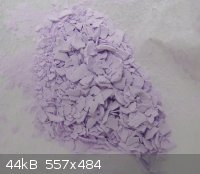
|
|
|
PHILOU Zrealone
International Hazard
    
Posts: 2893
Registered: 20-5-2002
Location: Brussel
Member Is Offline
Mood: Bis-diazo-dinitro-hydroquinonic
|
|
Quote: Originally posted by gnitseretni  | Finally got a chance to make some Nickel Hydrazine Nitrate. I decided to make it on a tiny scale for now. I powdered what you see in the pic and let
it dry some more. Then I took a very tiny sample on the edge of a small wood splinter and put a lighter to it. It burned as fast as AP does. Then I
took the NHN and wrapped it in some alu foil that was folded several times to increase thickness and added a fuse. Got out of my mancave and lit the
fuse. Was hoping to get a bang but all I got was just a quick "psssh" sound.
This stuff can be used on its own, right? Or am I supposed to mix it with another primary to get reliable detonation?
|
In tiny amounts you should not expect a great explosion or detonation that way (not wel confined)! Do the same tiny sample wrapped in one or twofold
layers of Al foil and hold it a few seconds over a candle flame with a long tool and you will see/ear the real power of the stuff.
Personnaly I like to mix Ni(N2H4)3(NO3)2 with Ag-C#C-Ag.xAgNO3.yHNO3 in a 2/1 ratio...so you get detonation even with low confinement.
PH Z (PHILOU Zrealone)
"Physic is all what never works; Chemistry is all what stinks and explodes!"-"Life that deadly disease, sexually transmitted."(W.Allen)
|
|
|
franklyn
International Hazard
    
Posts: 3026
Registered: 30-5-2006
Location: Da Big Apple
Member Is Offline
Mood: No Mood
|
|
UAN Fertilizer of Urea + Ammonium Nitrate is readily available as a solution
in a 1 to 1 molar ratio. Urea molar weight is 60 , Ammonium Nitrate molar
weight is 80 , so that Urea is 30 percent , Amonium Nitrate is 40 percent
and the balance is 30 percent water. Acidifying with even low concentartion
nitric acid will form Urea Nitrate in the solution with Ammonium Nitrate. When
dried it can be used as a low velocity blasting agent with slight positive oxygen
balance. http://en.wikipedia.org/wiki/UAN
4 NH4NO3 + 4 (NH2)CO • HNO3 => 4 CO2 + 18 H2O + 10 N2 + O2
Another composition not studied is to compound the UAN solution with
Hydrogen Peroxide. Urea forms an addition compound of Hydrogen Peroxide ,
Urea Peroxidate - see post by Axt
http://www.sciencemadness.org/talk/viewthread.php?tid=3214&a...
Recently Peroxidates of Ammonium Nitrate have been shown to be readily
obtained by vacuum evaporation of Ammonium Nitrate solution with
30 percent H2O2 which is available over the counter.
http://www.sciencemadness.org/talk/viewthread.php?tid=14308&...
http://www.sciencemadness.org/talk/viewthread.php?tid=608&am...
Urea Peroxidate decomposition products have a negative oxygen balance ,
and it does not exhibit any pyrotechnic ability given that it lies outside of the
explosive limits of mixtures of H2O2.
The detonation products of both Ammonium Nitrate and Hydrogen Peroxide
have positive oxygen balance and in 1 to 1 molar proportions this exactly
compensates for the oxygen deficiency of Urea Peroxidate.
2 NH4NO3 => 4 H2O + 2 N2 + O2
2 H2O2 => 2 H2O + O2
2 (NH2)2CO • H2O2 => 4 H2O + 2 CO + 2 N2 + 2 H2
NH4NO3 • H2O2 + (NH2)2CO • H2O2 => CO2 + 6 H2O + 2 N2
Drying UAN then again adding the mixed solute to a stoichiometric quantity
of Hydrogen Peroxide and vacuum evaporating the solution will produce a
double Peroxidate compound. This has not been written about or investigated.
.
|
|
|
Rosco Bodine
Banned
Posts: 6370
Registered: 29-9-2004
Member Is Offline
Mood: analytical
|
|
I am presently looking for references for bis-semicarbazide-copper(II)- diperchlorate and the zinc and nickel and manganese analogues
The copper salt should be Cu[(OC(NH2)NHNH2]2(ClO4)2
Here is a related article for the chloride salt of the complex
http://scripts.iucr.org/cgi-bin/paper?S0365110X65003791
And attached is a related patent US6127564
Attachment: US6127564 Semicarbazide Metal Complexes.pdf (79kB)
This file has been downloaded 1111 times
|
|
|
PHILOU Zrealone
International Hazard
    
Posts: 2893
Registered: 20-5-2002
Location: Brussel
Member Is Offline
Mood: Bis-diazo-dinitro-hydroquinonic
|
|
Quote: Originally posted by franklyn  | UAN Fertilizer of Urea + Ammonium Nitrate is readily available as a solution
in a 1 to 1 molar ratio. Urea molar weight is 60 , Ammonium Nitrate molar
weight is 80 , so that Urea is 30 percent , Amonium Nitrate is 40 percent
and the balance is 30 percent water. Acidifying with even low concentartion
nitric acid will form Urea Nitrate in the solution with Ammonium Nitrate. When
dried it can be used as a low velocity blasting agent with slight positive oxygen
balance. http://en.wikipedia.org/wiki/UAN
4 NH4NO3 + 4 (NH2)CO • HNO3 => 4 CO2 + 18 H2O + 10 N2 + O2
Another composition not studied is to compound the UAN solution with
Hydrogen Peroxide. Urea forms an addition compound of Hydrogen Peroxide ,
Urea Peroxidate - see post by Axt
http://www.sciencemadness.org/talk/viewthread.php?tid=3214&a...
Recently Peroxidates of Ammonium Nitrate have been shown to be readily
obtained by vacuum evaporation of Ammonium Nitrate solution with
30 percent H2O2 which is available over the counter.
http://www.sciencemadness.org/talk/viewthread.php?tid=14308&...
http://www.sciencemadness.org/talk/viewthread.php?tid=608&am...
Urea Peroxidate decomposition products have a negative oxygen balance ,
and it does not exhibit any pyrotechnic ability given that it lies outside of the
explosive limits of mixtures of H2O2.
The detonation products of both Ammonium Nitrate and Hydrogen Peroxide
have positive oxygen balance and in 1 to 1 molar proportions this exactly
compensates for the oxygen deficiency of Urea Peroxidate.
2 NH4NO3 => 4 H2O + 2 N2 + O2
2 H2O2 => 2 H2O + O2
2 (NH2)2CO • H2O2 => 4 H2O + 2 CO + 2 N2 + 2 H2
NH4NO3 • H2O2 + (NH2)2CO • H2O2 => CO2 + 6 H2O + 2 N2
Drying UAN then again adding the mixed solute to a stoichiometric quantity
of Hydrogen Peroxide and vacuum evaporating the solution will produce a
double Peroxidate compound. This has not been written about or investigated.
. |
Great idea Franklyn.
If NH4NO3 allows the formation of a peroxydate; and NH2-CO-NH2 also...then maybe NH2-CO-NH3NO3 might too hold some H2O2...
Then the double nitratoperoxydate might be interesting...to increase density and to make some more oxygen available to burn an organic matrix binder.
NH4NO3.H2O2 + NH2-CO-NH3NO3.H2O2 => CO2 + 13/2 H2O + 5/2 N2 + 5/2 O2
PH Z (PHILOU Zrealone)
"Physic is all what never works; Chemistry is all what stinks and explodes!"-"Life that deadly disease, sexually transmitted."(W.Allen)
|
|
|
franklyn
International Hazard
    
Posts: 3026
Registered: 30-5-2006
Location: Da Big Apple
Member Is Offline
Mood: No Mood
|
|
@ PHILOU Zrealone
" maybe NH2-CO-NH3NO3 might too hold some H2O2 "
That had not occurred to me. What's interesting about peroxidates is that
it opens an entirely new and as yet uninvestigated area of formulated
compositions which are solid molecular level mixtures. Because of the
high steam production these may be suitable as environmentally benign
propellants for example for possible use in automobile airbags.
.
|
|
|
Rosco Bodine
Banned
Posts: 6370
Registered: 29-9-2004
Member Is Offline
Mood: analytical
|
|
Here's a paper of interest. Sorry if this paper has already been posted. Also are the excerpted pages from PATR related to energetic hydrazine metal
complex salts.
Attachment: energetic_characteristics_of_transition_metal_complexes.pdf (305kB)
This file has been downloaded 1586 times
Attachment: Nitrohydrazinates and analogues PATR Vol. 7 H-L.pdf (374kB)
This file has been downloaded 1099 times
[Edited on 6-2-2013 by Rosco Bodine]
|
|
|
Rosco Bodine
Banned
Posts: 6370
Registered: 29-9-2004
Member Is Offline
Mood: analytical
|
|
There is a bis-hydrazine nickel azide which has about three times the small mass initiating impulse of tris-hydrazine nickel nitrate, and a comparable
grain size for the microcrystalline precipitate at about 80 microns. It would seem that these two compounds would make a nice complementary mixture.
I am uncertain if the reaction conditions would allow coprecipitation or formation of a possible mixed salt or double salt. A reference request has
been made to look further into this. Of course the bis-hydrazine nickel azide is interesting by itself as an initiator.
It is mentioned on page 21 of the attached paper, journal page is 313.
Attachment: Environmentally Friendly Energetic Materials for Initiation Devices Mikhail Ilyushin.pdf (1.3MB)
This file has been downloaded 1308 times
|
|
|
DraconicAcid
International Hazard
    
Posts: 4332
Registered: 1-2-2013
Location: The tiniest college campus ever....
Member Is Offline
Mood: Semi-victorious.
|
|
When I was a young lad, I read in the Rubber Bible (aka, CRC Handbook of Chemistry and Physics) that [Cu(NH3)4](NO3)2 was explosive. So, naturally, I
tried making some. I don't remember why it didn't work, but this thread inspired me to try it again. Easy prep- I dissolved 0.9 g of copper(II)
oxide in about 5 mL conc. nitric acid, and then added enough ammonia (with cooling) that the copper(II) hydroxide redissolved. I then added about 10
mL 95% ethanol, let it sit in an ice bath for a few minutes, and filtered. Let it dry in the fume hood overnight (with a big sign saying "Do NOT
Disturb!!"). It burned nicely, but I'd be hard-pressed to call it an explosion. I suppose it might have done so under the right conditions, but a
deflagration spoon isn't them.
|
|
|
Rosco Bodine
Banned
Posts: 6370
Registered: 29-9-2004
Member Is Offline
Mood: analytical
|
|
Quote: Originally posted by Rosco Bodine  | There is a bis-hydrazine nickel azide which has about three times the small mass initiating impulse of tris-hydrazine nickel nitrate, and a comparable
grain size for the microcrystalline precipitate at about 80 microns. It would seem that these two compounds would make a nice complementary mixture.
I am uncertain if the reaction conditions would allow coprecipitation or formation of a possible mixed salt or double salt. A reference request has
been made to look further into this. Of course the bis-hydrazine nickel azide is interesting by itself as an initiator.
It is mentioned on page 21 of the attached paper, journal page is 313. |
Attached are the additional articles Thanks to kmno4
Attachment: Studies on lead free initiators synthesis characterization and performance evaluation of transition metal complexes of c (411kB)
This file has been downloaded 1256 times
Attachment: Synthesis and Characterisation of Metal Hydrazine Nitrate, Azide and Perchlorate Complexes.pdf (651kB)
This file has been downloaded 2396 times
With regards to the semicarbazide complex of nickel perchlorate or in the alternative the more expensive cobalt perchlorate, these compounds appear to
be very promising as fairly easily made initiators. Excerpted from the article:
"The thermal as well as sensitivity characteristics
and limited performance evaluation of these metal complexes
bring out the potential of CoCP and NiCP as energyproviding
component of lead-free detonators for futuristic
programmes. These investigations also reveal that NiCP and
CoCP are superior detonants as compared to mercuric fulminate and service lead azide in terms of low vulnerability
to initiation by mechanical and thermal stimuli. It warrants
further in-depth trials for their adoption in detonators as ecofriendly and chemically compatible primary explosive. Practical data on the effect of
ageing on shelf life and performance change (useful life) of NiCP and CoCP need to be generated in future."
It appears likely that a detonator base charge also comprising a perchlorate would have absolute chemical compatibility with the initiator. Guanidine
perchlorate, methylamine perchlorate, trimethylamine perchlorate, and possibly other energetic perhlorates would seem to be candidates for the base
charge topped with the semicarbazide complex of nickel perchlorate as an initiator.
Experimental from the article:
Synthesis of nickel tris(carbohydrazide) perchlorate (NiCP)
A solution containing 3.66 g (0.02 mol) carbohydrazide in 35 cm3 of water was charged into a stainless steel reactor placed on a water bath. It was
kept under mechanical stirring
and heated to the temperature of 58–60 ◦C. 7.32 g (0.07 mol) of nickel perchlorate hexahydrate dissolved in 25–30 cm3 of double distilled
water was added to the carbohydrazide solution over a period of 20 min at 58–60 ◦C. The addition of the reactant resulted in marginal
exothermic reaction leading to an increase in the temperature of the contents. The reaction mixture was allowed to remain at 58–60 ◦C for
about 30 min.
Subsequently, the reaction flask was removed from the water
bath and digested at room temperature with stirring for an
hour. The light blue crystals of NiCP obtained were filtered
through a Buchner funnel. The bluish coloured crystals were
washed with distilled water (4×50 cm3), followed by propyl
alcohol (50 cm3) and dried at 60 ◦C. The yield obtained was
8.9 g (85%). Similar procedure was adopted for the synthesis
of CoCP, CuCP and ZnCP of free-flowing nature. The molar
ratio of copper perchlorate and carbohydrazide used during
the synthesis of CuCP was 1:2.1.
An attempt was also made to synthesize these complexes
at a lower temperature (25 ◦C) adopting the above procedure. The products obtained at lower temperature were found amorphous in nature with less
yield (60–70%) and lower bulk densities (0.65–0.74 g/cm3). The intensity of the colour of these complexes obtained at lower temperature was
slightly light in comparison to the products obtained at 65 ◦C. The reaction time required to complete the reaction at 25–30 ◦C was of
the order 1 h. The compounds obtained at 58–60 ◦C were selected for further studies.
Note: There appears to be errata in Table 1 at the bottom of page 2 of the pdf (page 58 of the journal) where the sensitivity to impact figures are
transposed for the Ni and Cu compounds. This table errata would need to be confirmed as it does not match the text of the article.
[Edited on 14-2-2013 by Rosco Bodine]
|
|
|
franklyn
International Hazard
    
Posts: 3026
Registered: 30-5-2006
Location: Da Big Apple
Member Is Offline
Mood: No Mood
|
|
Explosive coordination compounds remain obscure and little exploited or
investigated. Some of these show intriguing potential for application as
detonation initiators aside from the few that have seen such use.
For some time I had the notion that a complex with Cyanide can serve
better as fuel than Ammonia based types , but being an anion itself hinders
the prospect of binding with oxidative anions such as Nitrate. I have become
aware of a long forgotten ( it would seem ) compound of this type. The
oxidizer functional group is Chromium IV oxide , CrO4 , which remarkably
forms a double salt with Potassium Cyanide. The temperature of explosion
is a bit low , and may prove to be too sensitive for general application , but
serves to show that compounds of this type can serve as the first charge
in a compound detonator set off by flame or electric element.
It is described in the following first two citations here _
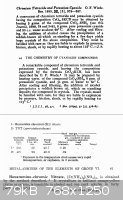
The third citation above is an excerpt from Explosive Properties of Metal Ammines
www.sciencemadness.org/talk/viewthread.php?tid=1778&page...
featuring the commendable properties of another Chromium based complex
Hexamino Chromic Nitrate which is as powerful as TNT with a sensitiveness
to impact like that of RDX , making it very suitable for use as the base of
a compound detonator with the above compound if that proves capable.
CrO4•3KCN is described on page 96 of
Per-acids and Their Salts , See Chapter VIII Perchromates , pg 92
The precursor compound is detailed here on page 95
http://books.google.com/books?id=kxFDAAAAIAAJ&pg=PA95&am...
Download the book ( enter captcha )
http://books.google.com/books/download/Per_acids_and_their_s...
X-Ray Studies on Some Alkali and Alkaline-Earth Chromates
Acta Chem. Scand. 19, 177 (1965) , K. A. Wilhelmi & 0. Jonsson
http://actachemscand.dk/pdf/acta_vol_19_p0177-0184.pdf
Has prep for CrO4
Cr203 in fused (725 ºC) Li2CO3 => Li3CrO4
The following are excerpted from here _ Inorganic Reaction Mechanisms
http://books.google.com/books?id=jGvRKef2pZIC&pg=PA145&lpg=PA145
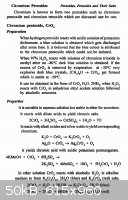 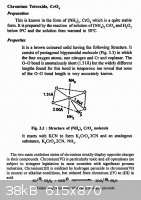
Hexamino-Chromic-Nitrate described above is detailed on page 81 here _
A Text Book of Inorganic Chemistry vol X - The Metal Ammines
https://ia600502.us.archive.org/9/items/textbookofinorga0288...
See pg 74 Amino Derivatives of Chromium Salts ,
Another which appears promising , Nitro-Pentamino-Chromic Nitrate
and it's precursor Chloro-Pentamino-Chromic Chloride , are described
on page 94 , excerpted here below.
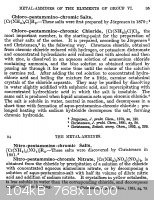
___________________________________________________
Continuing with the opening premise of this post , the inclusion of cyanide
in an energetic inorganic compound by the prospect of forming a double salt
whereby it is co-crystallized with a nitrate.
It's been known a long time , as stated in Commercial Organic Analysis - 1896
http://books.google.com/books?id=ppDPAAAAMAAJ&pg=PA428&a...
" Heated with KNO3 or KClO3, the metallic cyanides detonate strongly."
Sodium cyanide is somewhat more reactive; contact with nitrates, peroxides,
chlorates, and nitric acid can cause explosions. It explodes if melted with nitrite
at over 450 °C , but apparently will not from impact when struck.
Potassium cyanide will also explode in contact with nitrogen chloride and some
nitrates. Sodium cyanide is also more dangerous to handle, since the amount
of CO2 in the air is enough to react with it to release hydrogen cyanide gas.
Sodium cyanide is more dense at 1.6 grams per milliliter as compared to
1.52 grams per milliliter for potassium cyanide.
The immediate problem that arises is the disparate solubilities of prospective
salts , making it likely that the cyanide typically less soluble than the nitrate
will precipitate separately from solution. Despite these issues there is in fact
one known double salt of this type , KCN • KNO2 , as described here _
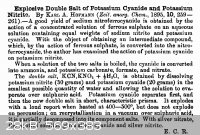
The presence of retained water tends to inhibit explosive propensity and in
this case is difficult to remove by ordinary drying procedures. Anhydrous
solvation may provide a better product. The solubility of KCN and NaNO2
are within a 10 percent of each other at room temperature.
KCN
Solubility in methanol 49.1 g/L (20 °C)
NaNO2
Solubility in methanol 44.3 g/L (19.5 ºC)
It would seem that mixing together two saturated solutions stoichiometrically
balanced for a 1 : 1 ratio , contained in a filtration flask which is sealed and
subject to continuous vacuum while gently warmed , will evaporate the solvent
forcing crystallization of the two solutes as an anhydrous double salt.
Note that in solution double decomposition will result in the formation
of KNO2 , NaCN , solubility for these salts will differ somewhat from
that of the initial KCN , NaNO2. What little data I can find does not appear
to militate against the basic premise at this time.
A compound which is oxygen balanced would be based on Alkaline metal salts.
Ca(CN)2 + Ca(NO3)2 => 2 CaO + 2 CO2 + 2 N2 , for example would prove
to be very powerful given the expected density is well over 2 gm/cc .
Calcium Cyanide is unstable easily hydrolysed on it's own , Magnesium is even
more so. http://magnesium.atomistry.com/magnesium_cyanide.html
.
[Edited on 20-2-2013 by franklyn]
|
|
|
| Pages:
1
..
11
12
13
14
15
..
27 |